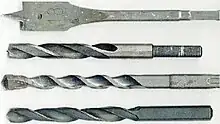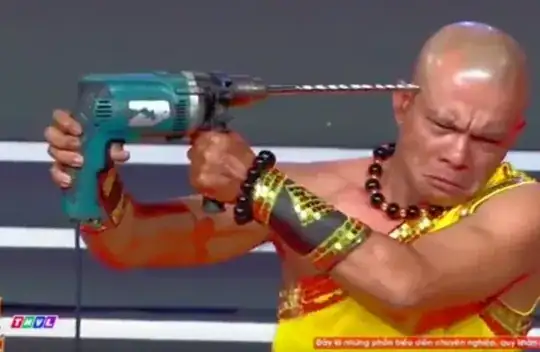Note: the supporting material in this answer contains references to
suicide.
If you feel suicidal, please consider getting help
The literature call severe injuries related to drill bits 'extremely rare', most of the reported are connected with a fatality, which, reading the articles, is not due to the special lethality of drill bits, but rather that fatalities get reported on more. Actually, many of the cases involve non-lethal injuries by bit, even when the bit penetrated the brain. If death then followed, it was often due to drill-unrelated injuries.
Less severe drill bit injuries seem run-of-the-mill, as evidence by them appearing in an overview of pandemic-hobby injuries, but not as reports separate from such a meta-theme.

From top: Spade, brad point, masonry, and twist drills bits.
Even the masonry drill bit, which is not sharp in the classical sense, can be lethal if enough force is applied. A twist drill bit can create deep cuts when a glancing blow is dealt. In penetrating wounds, the entry wound, due to the cutting action and the elastic nature of skin, is smaller7 or as big than the later canal through bone, or as big as the drill bit - interestingly, the wound pattern of twist- and wood-drill (brad point) bit are very similar.
If the rotating chuck of the machine hits the skin, abrasion and burns follow (yet with the higher velocity of the larger chuck, this can not necessarily be used as a comparison for an ultra-dull drill bit). While most of the cited injuries where caused by force consistent with human effort, an accidental injury (fatal) could have involved larger forces, due to the fall from a step ladder.
Drill bits can also penetrate the skin above soft tissue of, e.g., the hand or the throat without bone directly underlying the site, as is the case in cranial injuries.
None of the sources mention chi-use, either on the side of the one wielding the drill, nor on the receiving side (which in many but not all cases is the same). The issue of mental concentration is not raised, nor implicitly covered (like 'patient, 43, non-monk, presented to the emergency room,...).
The 'monk vs drill' videos consistently show the use of a two-hand-grip drill, where the forehand could work against the backhand to produce a very low, measured, amount of thrust onto the body

In the History channel docu-flick they also show that there is indeed damage to the skin (if only abrasive).

In none of the videos is the drill bit shown to be effective against anything, it is thus left open whether the bit is actually sharp, or even non-dull; In real injuries with a drill bit, where the drill bit entered until the chuck hit the skin, the chuck did not penetrate, but abrade and burn the skin, showing that a completely dull, rotating surface does not penetrate (with the forces involved in these incidents). The drill bit of the monks does not penetrate, but abrade. As shown in the forensic experiments, the action of normal twist drill bits against skin is a cutting one, while performative Shaolin monks are never shown to be impervious to other cutting action, always blunt force.
Non-monks can do something very similar one-handed, even. (Note the direction the drill seems to be going vs where he says it goes)


